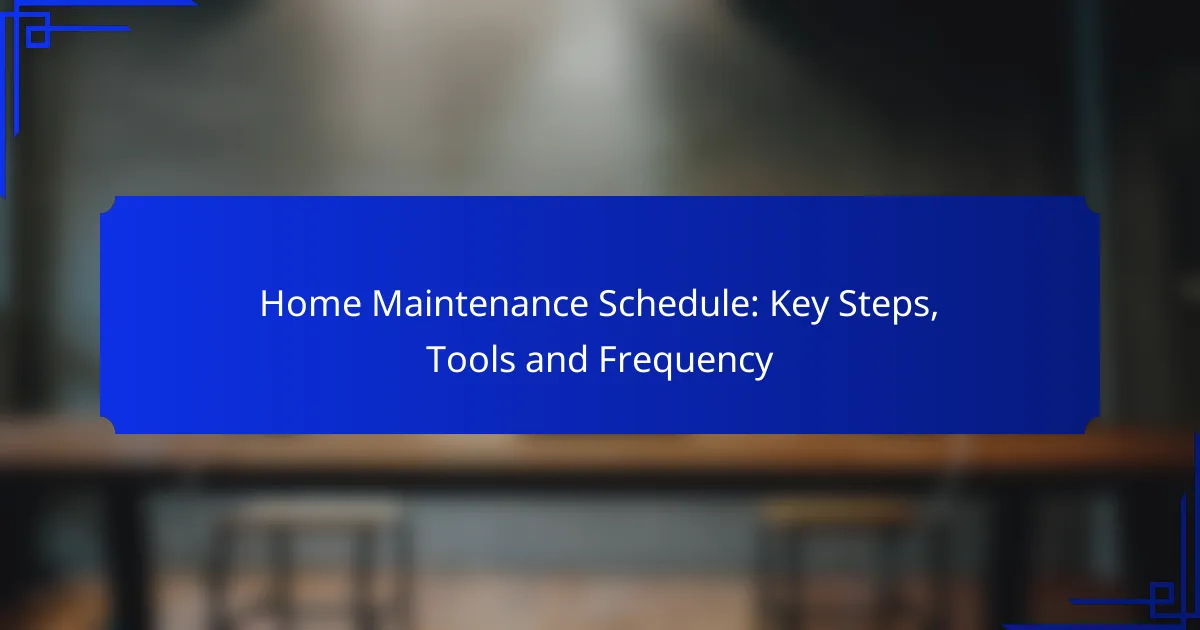A home maintenance schedule is essential for keeping your property safe and functional. By incorporating systematic tasks such as seasonal inspections and regular cleaning, you can enhance the longevity and efficiency of your home. Utilizing the right tools and adhering to a structured schedule ensures that maintenance tasks are performed regularly, preventing costly repairs and promoting a well-maintained living environment.
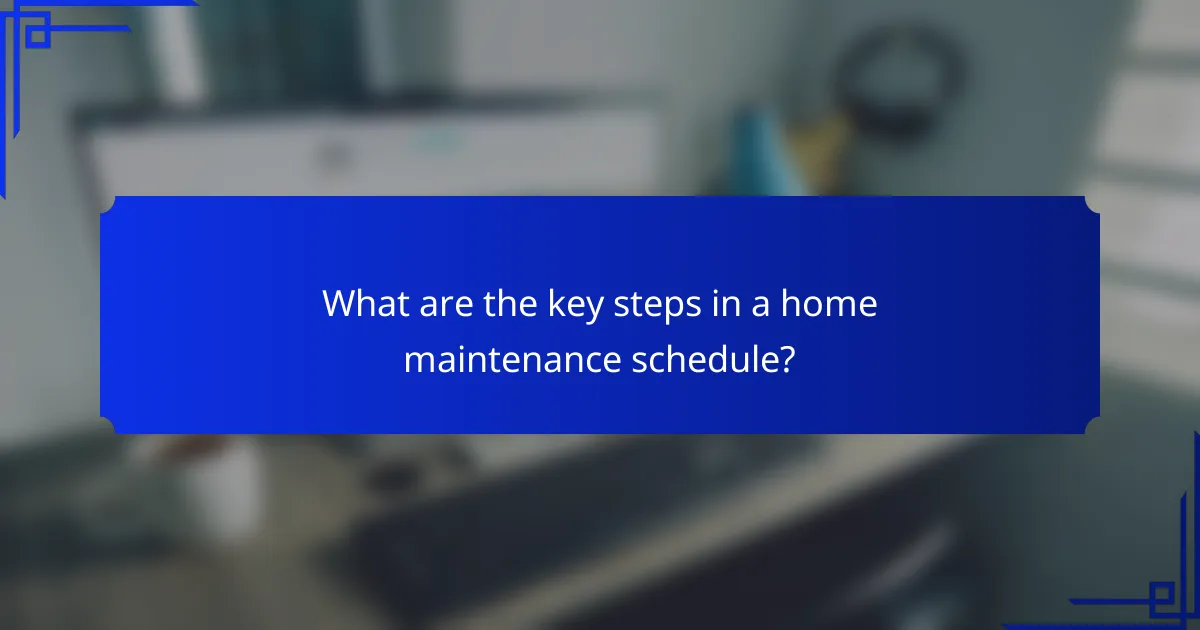
What are the key steps in a home maintenance schedule?
A home maintenance schedule involves systematic tasks to ensure your property remains safe and functional. Key steps include seasonal inspections, regular cleaning tasks, and annual repairs, each contributing to the longevity and efficiency of your home.
Seasonal inspections
Seasonal inspections are crucial for identifying potential issues before they escalate. Typically, these inspections should occur at the start of each season, focusing on areas like roofing, gutters, plumbing, and HVAC systems.
For example, in spring, check for roof damage from winter weather and ensure gutters are clear to prevent water damage. In fall, inspect heating systems to ensure they are ready for winter use.
Regular cleaning tasks
Regular cleaning tasks help maintain a healthy living environment and prevent buildup that can lead to costly repairs. Aim to perform cleaning tasks weekly, monthly, and quarterly.
- Weekly: Vacuum and dust to reduce allergens.
- Monthly: Clean appliances like the refrigerator and oven.
- Quarterly: Deep clean carpets and check for mold in damp areas.
Annual repairs
Annual repairs are essential for addressing wear and tear that accumulates over time. These tasks often include servicing major appliances, inspecting the roof, and checking the foundation for cracks.
Consider budgeting for these repairs, as they can range from a few hundred to several thousand dollars depending on the extent of the work needed. Prioritize repairs based on urgency and potential impact on your home’s safety and value.

What tools are essential for home maintenance?
Essential tools for home maintenance include a variety of hand tools, power tools, and safety equipment. Having the right tools on hand can simplify repairs and upkeep, ensuring your home remains in good condition.
Basic hand tools
Basic hand tools are fundamental for any home maintenance task. Essential items include a hammer, screwdrivers (both flathead and Phillips), pliers, a tape measure, and a utility knife. These tools are versatile and can handle a wide range of repairs from assembling furniture to fixing loose fixtures.
When selecting hand tools, consider quality over quantity. Investing in durable tools can save money in the long run, as they are less likely to break or wear out quickly. A well-organized toolbox can help you find the right tool when you need it.
Power tools
Power tools can greatly enhance your efficiency in home maintenance tasks. Common power tools include drills, saws, and sanders, which can make cutting, drilling, and finishing tasks much faster and easier. For instance, a cordless drill can be invaluable for quick assembly or repairs.
While power tools can be more expensive, they often provide better results and save time. Always read the manufacturer’s instructions and follow safety guidelines when using these tools to prevent accidents.
Safety equipment
Safety equipment is crucial for protecting yourself during home maintenance tasks. Essential safety gear includes gloves, goggles, and dust masks. These items help prevent injuries from sharp objects, flying debris, and harmful dust or fumes.
Before starting any project, ensure you have the appropriate safety equipment readily available. Regularly check your gear for wear and replace it as necessary to maintain your safety standards. Remember, taking the time to prioritize safety can prevent costly accidents and injuries.
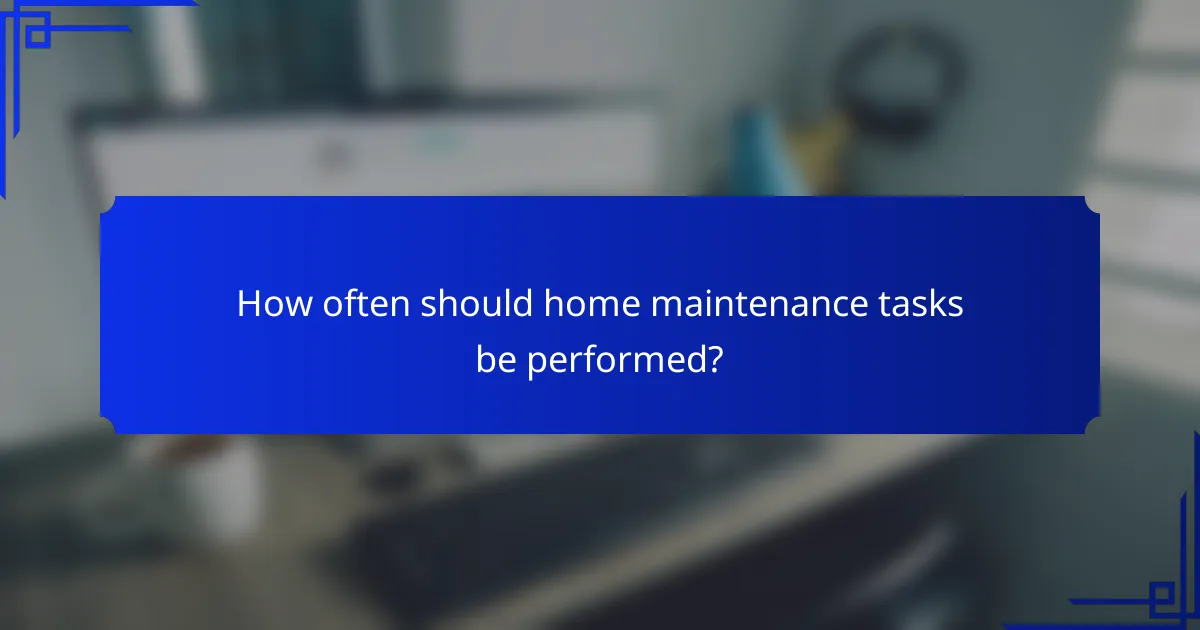
How often should home maintenance tasks be performed?
Home maintenance tasks should be performed regularly to ensure the longevity and safety of your property. A structured schedule, including monthly, quarterly, and annual tasks, helps prevent costly repairs and keeps your home in good condition.
Monthly tasks
Monthly maintenance tasks are essential for keeping your home running smoothly. Check and replace air filters in HVAC systems to maintain air quality and efficiency. Inspect smoke detectors and carbon monoxide detectors to ensure they are functioning properly.
Additionally, clean kitchen appliances like the refrigerator coils and the dishwasher filter to prevent buildup that can lead to malfunctions. Regularly check for leaks under sinks and around toilets to catch potential issues early.
Quarterly tasks
Quarterly tasks involve more in-depth inspections and maintenance. Check the exterior of your home for signs of wear, such as peeling paint or damaged siding, and address these issues promptly. Clean gutters and downspouts to prevent water damage and ensure proper drainage.
It’s also a good time to inspect your home’s plumbing for leaks and check the water heater for sediment buildup. Consider testing your sump pump if you have one, ensuring it operates correctly before heavy rain seasons.
Annual tasks
Annual maintenance tasks are crucial for long-term home health. Schedule a professional inspection of your heating and cooling systems to ensure they are operating efficiently. This can help extend the life of the equipment and improve energy efficiency.
Inspect your roof for missing shingles or signs of wear and have any necessary repairs made. Additionally, consider servicing major appliances like the furnace or air conditioner to keep them running smoothly. Don’t forget to check your home’s foundation for cracks and address any drainage issues around your property.
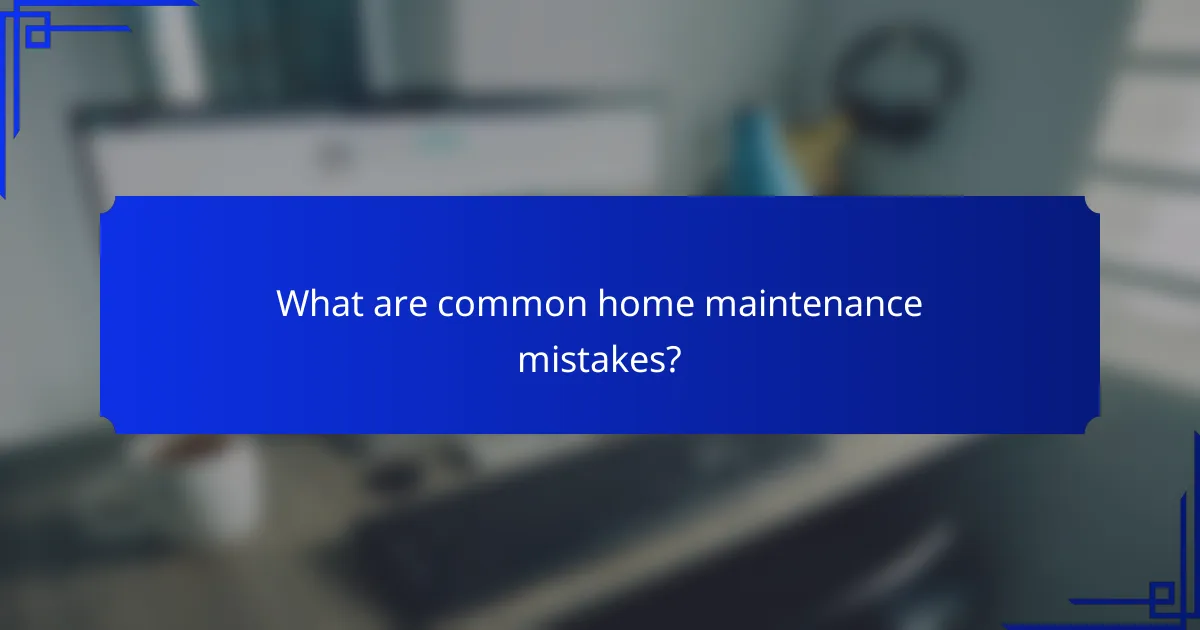
What are common home maintenance mistakes?
Common home maintenance mistakes include neglecting seasonal tasks, ignoring warning signs of damage, and using incorrect tools for repairs. These oversights can lead to costly repairs and decreased home value.
Neglecting seasonal tasks
Neglecting seasonal tasks can result in significant damage to your home. For instance, failing to clean gutters in the fall may lead to water damage in the winter. Regularly scheduled maintenance, such as checking the roof and inspecting HVAC systems, should be part of your seasonal routine.
To avoid this mistake, create a seasonal checklist that includes tasks like changing air filters, inspecting insulation, and checking for leaks. Aim to complete these tasks at least twice a year, ideally before the onset of extreme weather conditions.
Ignoring warning signs
Ignoring warning signs, such as water stains, unusual noises, or musty odors, can lead to larger issues down the line. These signs often indicate underlying problems that require immediate attention, such as plumbing leaks or structural damage.
Be proactive by regularly inspecting your home for these indicators. If you notice any warning signs, address them promptly to prevent further damage and costly repairs. Keeping a maintenance log can help you track issues and solutions over time.
Using incorrect tools
Using incorrect tools can lead to ineffective repairs and potential damage to your home. For example, using a hammer instead of a mallet on delicate surfaces can cause dents and scratches. Always ensure you have the right tools for the job.
Invest in a basic toolkit that includes essential items like screwdrivers, pliers, a level, and a tape measure. Familiarize yourself with each tool’s purpose and proper usage to avoid mishaps. If unsure, consult instructional resources or seek professional help for complex tasks.
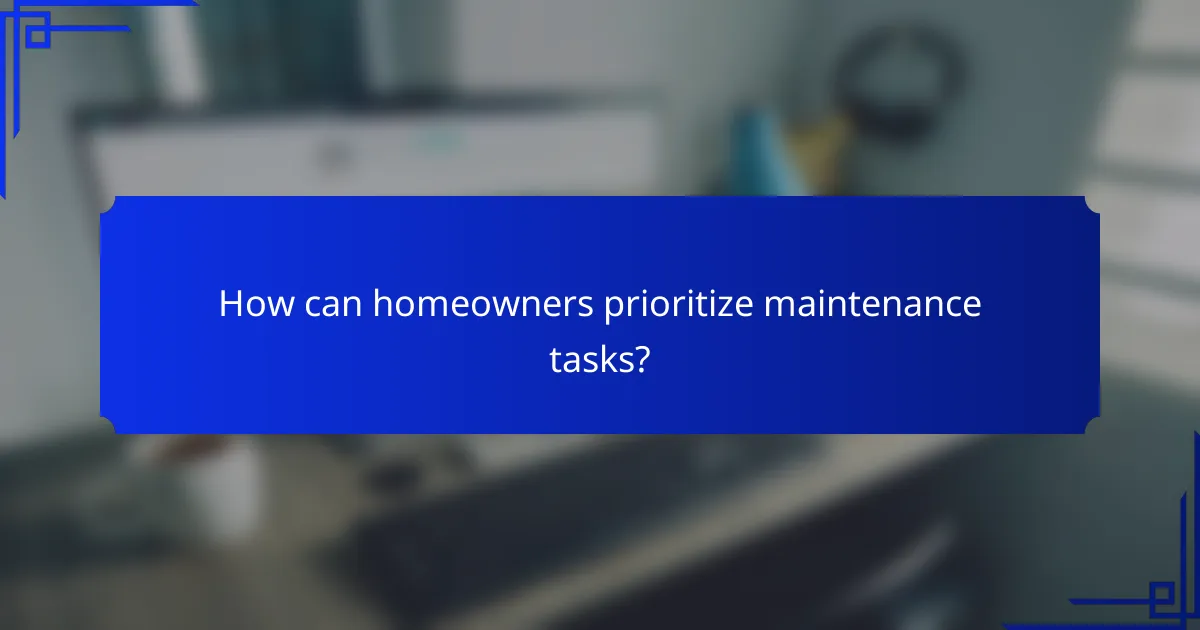
How can homeowners prioritize maintenance tasks?
Homeowners can prioritize maintenance tasks by assessing the urgency and importance of each task, ensuring that critical issues are addressed promptly. This approach helps in maintaining the home’s value and safety while preventing costly repairs in the future.
Assessing urgency
To assess urgency, homeowners should consider factors such as safety risks, potential for damage, and seasonal requirements. For example, a leaky roof should be prioritized over a minor paint touch-up, as it can lead to severe structural damage if not addressed quickly.
Additionally, consider the time of year; tasks like gutter cleaning are more urgent before heavy rain seasons. Regularly inspecting your home can help identify urgent issues early, allowing for timely intervention.
Creating a checklist
A maintenance checklist is a practical tool for homeowners to keep track of tasks and their priorities. Start by listing all essential maintenance tasks, categorizing them by frequency—monthly, quarterly, or annually. This organization helps in visualizing what needs immediate attention versus what can wait.
For instance, a checklist might include changing air filters monthly, inspecting smoke detectors quarterly, and cleaning the chimney annually. Regularly updating this list ensures that no important tasks are overlooked, making home maintenance more manageable.
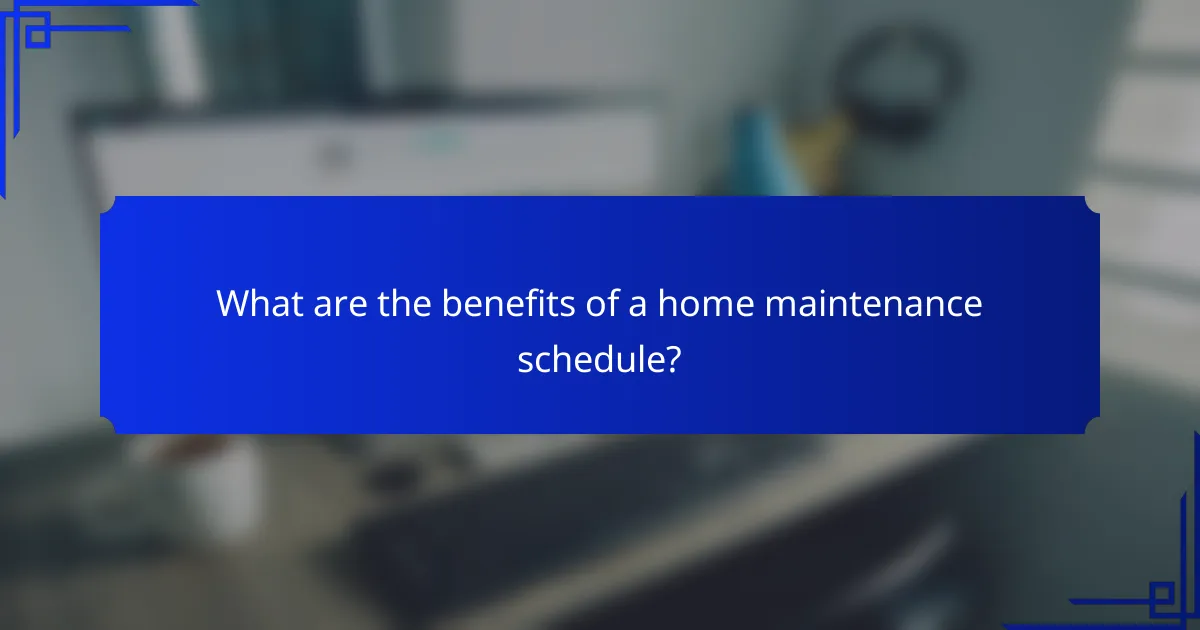
What are the benefits of a home maintenance schedule?
A home maintenance schedule provides numerous advantages, including preserving property value and enhancing safety. By regularly addressing maintenance tasks, homeowners can prevent costly repairs and create a safer living environment.
Increased property value
Regular maintenance helps maintain and potentially increase your home’s value. Properties that are well-kept often attract higher offers and sell faster compared to those with visible neglect.
Consider tasks such as painting, landscaping, and roof inspections as part of your schedule. These actions can enhance curb appeal and ensure that your home meets local real estate standards, which can be crucial when selling.
Improved safety
A comprehensive maintenance schedule significantly contributes to the safety of your home. Regular checks on systems like electrical, plumbing, and HVAC can identify potential hazards before they escalate into serious issues.
For instance, inspecting smoke detectors and carbon monoxide alarms should be done at least twice a year. Additionally, ensuring that walkways are clear and well-lit can prevent accidents, especially during winter months when ice may form.
